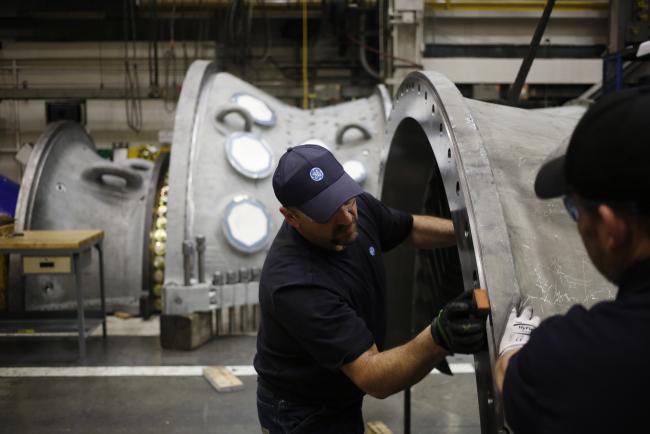(Bloomberg) -- General Electric's (NYSE:GE) gaping pension deficit certainly stands out for its size. But the company is hardly the only one at risk of potentially shortchanging some of its employees come retirement.
All across corporate America, underfunded pensions have become the norm. Even now, a decade after the financial crisis, the largest plans face a shortfall of $269 billion, right about where it was 10 years ago. Years of low interest rates have largely offset gains in the stock market. Companies haven’t helped matters by lavishing money on shareholder rewards and clinging to assumptions about returns that proved to be too rosy.
The situation isn’t likely to improve any time soon, particularly if interest rates keep falling. Even though a banner year in both stocks and bonds lifted returns on the largest pensions by 12% this year, their liabilities have grown even faster, according to consulting firm Milliman. And while GE’s move to freeze benefits and set aside money will help trim its $22.4 billion pension shortfall by as much as $8 billion, Chief Executive Officer Larry Culp said last month that low rates could boost those same liabilities by roughly $7 billion.
In other words, unless companies take even more drastic steps, they’re currently doing little better than treading water.
“Plan sponsors are getting concerned that we’ve had a historic equity run in the market and they’re still sitting on underfunded pension positions,” said Steve Keating, managing director at BCG Pension Risk Consultants.
Part of it has to do with what’s called the discount rate, which for corporate pensions typically corresponds to yields on highly rated corporate bonds.
Simply put, the lower the discount rate, the less a plan assumes it will earn over time. That means the plan needs to set aside more money today to cover retirement benefits a company has promised to pay its employees in the years and decades to come. In August, the discount rate fell to an average of 2.95%, the lowest level in the 19-year history of Milliman’s pension funding index.
Defined benefit plans, like your traditional corporate pensions, have largely disappeared from view in the past couple of decades as companies have embraced plans like 401(k)s. Employers can opt to contribute to those plans, but it’s the employees who are responsible for choosing the right investments and are solely on the hook if those investments fare poorly.
Nevertheless, there are plenty of older employees and retirees that are collectively still owed tens of billions of dollars in benefits that companies have failed to adequately fund.
GE’s predicament underscores the scope of the problem. On Monday, the company said it would freeze pension benefits for more than 20,000 employees and set aside as much as $5 billion to cover future obligations. (For those who didn’t grow up with pensions, “freezing” benefits essentially means whatever you’ve accrued thus far is what you get from that plan, and no more, regardless of how many more years you work for that company.) And for GE, that helps reduce the amount they’ll ultimately need to pay out.
Yet at the end of 2018, GE owed benefits to at least 600,000 people worldwide, amounting to nearly $92 billion in future payouts. Globally, its pension plans had just $69 billion in assets.
To be fair, many companies probably didn’t expect interest rates, which fell to rock-bottom levels as a result of the Federal Reserve’s crisis-era monetary policies, to stay so low. Outside of brief periods during parts of 2013 and 2018, when bond yields looked like they were finally about to return to historical norms, they’ve kept falling. That’s had real-world consequences for retirees who not only rely on a fixed income, but are also living longer as well.
“Even though the equity markets have done pretty well this year, it’s been hard for them to make up ground” because of low rates, said Beth Ashmore, a managing director for retirement at Willis Towers Watson (NASDAQ:WLTW) Plc. Despite the stock market run since the crisis, “funding levels really haven’t recovered as much as everybody would have hoped.”
While many companies have plenty of money to plug or significantly reduce their pension deficits if they wanted to right now, others do not. GE has $32 billion in cash and equivalents, enough to wipe out its deficit (setting aside, of course, its many other debt obligations.) On the other hand, Delta Air Lines Inc (NYSE:DAL). has $6.4 billion in unfunded liabilities and just $2 billion in cash.
Some have sought to transfer their pension liabilities to life insurers. The market for single premium buyouts reached $26 billion last year, according to data from industry group Limra. Earlier this year, Lockheed Martin Corp (NYSE:LMT). said that it struck deals with Prudential Financial Inc (NYSE:PRU). and Athene Holding Ltd. to transfer billions in pension obligations.
Others like United Parcel Service Inc (NYSE:UPS). have taken advantage of low borrowing costs to finance their pension contributions in the debt markets. Chipping away at a shortfall can help companies cut back on payments to the Pension Benefit Guaranty Corp., a government agency that helps backstop plans. The agency has been ratcheting up rates for companies that maintain pension deficits in recent years, in an effort to get them to plug those shortfalls.
“I think CFOs, in some ways, want to take control and start to thoughtfully reduce the size of their pension plan over time,” BCG’s Keating said.
Whatever the case, it’s often the employees who end up losing out. Freezing pensions has become a more popular strategy for companies in recent years. A decade ago, about 20% of Fortune 500 companies with pension plans in place since 1998 had frozen their plans, according to Willis Towers Watson. Since then, that figure has swelled to 42%.
“In a situation of ‘corporate battlefield surgery,’ this tends to be a typical, if unfortunate, casualty,” said Julian Mitchell, an analyst at Barclays (LON:BARC) Plc.
